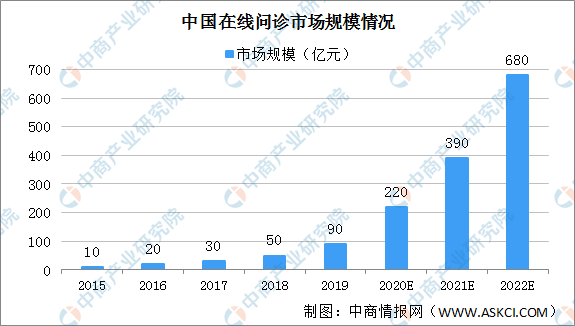The scale of China’s eHealth market will reach 22 billion in 2020, showing three major development trends
The eHealth (Telehealth, Virtual Care, Virtual Visit, mHealth, digital health) generally covers consultation and prescription renewal, follow-up consultations, hospital appointments, and chronic disease management. The scale of China’s online medical consultation market was only 1 billion in 2015, and it increased to 9 billion US dollars in 2019, with a composite strength of 58.5% from 2015 to 2019. The pneumonia epidemic is sufficient to raise awareness of health care, and it also increases the acceptance of eHealth, so that consumers can develop a long-term habit of using eHealth. Combined with the support policy environment that is expected to further standardize services, eHealth will become more efficient, more reliable, and of better quality. It is estimated that China’s online consultation market will reach 22 billion in 2020, and the market will increase to 68 billion in 2022.
eHealth market, year/billion yuan

Two factors drive the development of China’s eHealth market
1. Uneven distribution of offline medical resources
China’s medical resources are concentrated in large-scale tertiary hospitals, which account for only 8% of the total number of hospitals in the country, but in 2019, outpatient visits accounted for 52% of the total outpatient visits. The tertiary hospitals are concentrated in wealthier cities and provinces. Medical resources and diagnostic needs are severely inverted and unevenly distributed, resulting in poor patient experience. In contrast, online consultation is highly efficient and can provide patients with convenient and high-quality medical resources no matter where they are. More importantly, online consultation is expected to effectively realize the diversion of online and offline patients and become a key component of China’s hierarchical diagnosis and treatment system, thereby further reducing the burden on China’s current medical and health system.
2. Continuously expanding service capabilities and influence
Through the two-way referral with offline medical institutions and the advancement of online medical technology, online can provide people with more and better medical and health services. It is expected that the influence of eHealth in the entire consultation chain will expand, covering services from disease prevention to after-treatment care, while integrating online and offline medical resources.
China’s eHealth market presents three major development trends
1. Effective chronic disease management
It is expected that chronic disease management will increasingly rely on digitalization. Online digital diagnosis and treatment services can become an effective tool for managing patient health records and paying for the entire life cycle of chronic diseases (such as diabetes, hypertension, and coronary heart disease).
2. Personalized treatment
Can better store and analyze personal health files online, so as to more accurately match patients and possible treatment plans. With the further expansion of online medical and health services, more data can be collected to provide users with easier-to-use and more personalized treatment programs.
3. Increased participation of medical experts
Experts, well-known doctors, and doctor groups tend to focus on more complex and serious diseases. However, if digital platforms can attract relevant key personnel and allow them to invest time in online practice, these platforms will have a significant first-mover advantage to further expand the services they provide.
(Source: China Commercial Industry Research Institute)

